
Plectorhinchus chaetodonoides, the harlequin sweetlips, clown sweetlips, spotted sweetlips or many-spotted sweetlips, is a species of marine ray-finned fish, a sweetlips belonging to the subfamily Plectorhinchinae, one of two subfamilies in the family Haemulidae, the grunts. It is native to the Indo-Pacific region. This species is of minor importance to local commercial fisheries and can be found in the aquarium trade.

The Indian Ocean oriental sweetlips, also known as the oriental sweetlips or oriental blubberlips, is a species of marine ray-finned fish, a sweetlips belonging to the subfamily Plectorhinchinae, one of two subfamilies in the family Haemulidae, the grunts. It is native to the Indian Ocean and the western Pacific Ocean.

Plectorhinchus polytaenia, the ribboned sweetlips, also known as Tesone di mare or yellow-ribbon sweetlips, is a species of marine ray-finned fish, a sweetlips belonging to the subfamily Plectorhinchinae, one of two subfamilies in the family Haemulidae, the grunts. It is native to the Indian Ocean and the western Pacific Ocean.

Plectorhinchus pica, the painted sweetlips, dotted sweetlips, magpie sweetlips or spotted sweetlips, is a species of marine ray-finned fish, a sweetlips belonging to the subfamily Plectorhinchinae, one of two subfamilies in the family Haemulidae, the grunts. It is native to coral reefs of the Indian Ocean and the western Pacific Ocean. It is a commercially important species and can be found in the aquarium trade.
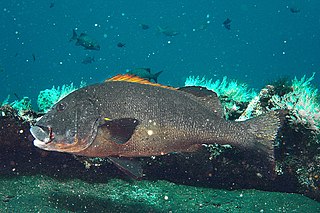
Plectorhinchus albovittatus, the two-striped sweetlips or giant sweetlips, is a species of marine ray-finned fish, a sweetlips belonging to the subfamily Plectorhinchinae, part of the grunt family Haemulidae. It is native to the Indian Ocean and the western Pacific Ocean.

Diagramma is a genus of marine ray-finned fishes belonging to the family Haemulidae, grunts native to the Indian Ocean and the western Pacific Ocean. The currently recognized species in this genus are:
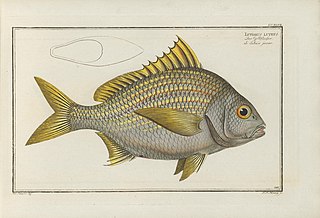
Genyatremus luteus, the Torroto grunt, is a species of marine ray-finned fish, a sweetlips belonging to the subfamily Plectorhinchinae of the family Haemulidae. It is native to the Atlantic coast of South America from Colombia to Brazil.

The blackfin slatey, also known as blackfoot sweetlips, blackfin sweetlips or blacktip sweetlips, is a species of marine ray-finned fish, a sweetlips belonging to the family Haemulidae. It is found in the eastern Indian Ocean and the western central Pacific Ocean.

The painted sweetlips, also known as the Australian slatey, blackall, bluey, grey sweetlips, moke, morwong, mother-in-law fish, painted blubber-lips, slate bream, slate sweetlips, smokey bream, thicklip or yellowdot sweetlips is a species of marine ray-finned fish, a sweetlips belonging to the family Haemulidae. It is widespread throughout the tropical waters of the Indo-West Pacific region.
Plectorhinchus ceylonensis, the Sri Lanka sweetlips, is a species of marine ray-finned fish, a sweetlips belonging to the subfamily Plectorhinchinae, one of two subfamilies in the family Haemulidae, the grunts. It is native to the Indian Ocean around Sri Lanka. It inhabits waters over coral reefs at depths from 5 to 20 m. This species is rarely found in the aquarium trade.

Pomadasys kaakan, the javelin grunter or barred javelin is a species of marine ray-finned fish, a grunt belonging to the family Haemulidae. It is native to the Indian and Pacific Oceans, from Africa to Australia.
Plectorhinchus macrospilus, the largespot sweetlips, largespot thicklips or Andaman sweetlips, is a species of marine ray-finned fish, a sweetlips belonging to the subfamily Plectorhinchinae, one of two subfamilies in the family Haemulidae, the grunts. It is native to the north eastern Indian Ocean.
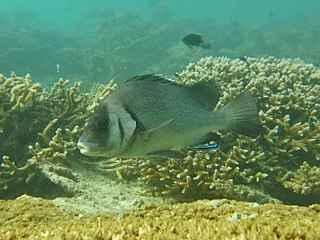
Plectorhinchus gibbosus, commonly known as the Harry hotlips, black sweetlips, brown sweetlips, dusky sweetlips, gibbous sweetlips, hairy hotlips or humpback sweetlips, is a species of marine ray-finned fish, a sweetlips belonging to the subfamily Plectorhinchinae, one of two subfamilies in the family Haemulidae, the grunts. It is native to the Western Pacific and Indian Oceans.
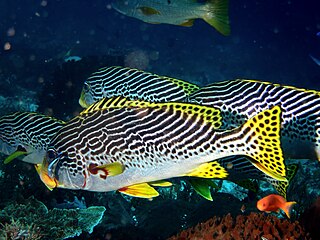
Plectorhinchus lineatus, also known as the yellowbanded sweetlips, oblique-banded sweetlips, diagonal-banded sweetlips, Goldman's sweetlips, lined blubber-lips, lined sweetlips, many-lined sweetlips, striped sweetlips and yellowband sweetlips, is a species of marine ray-finned fish, a sweetlips belonging to the subfamily Plectorhinchinae, one of two subfamilies in the family Haemulidae, the grunts. It inhabits coral reefs of the western Pacific Ocean, where it occurs at depths from 1 to 35 m.

Plectorhinchus caeruleonothus, the blue bastard, is a species of ray-finned fish belonging to the subfamily Plectorhinchinae, the sweetlips, one of two subfamilies in the family Haemulidae, the grunts. It was discovered in Australia in 2015.
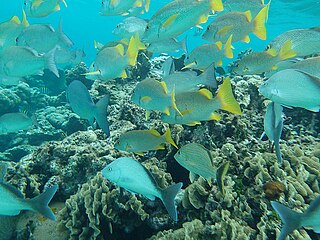
Haemulon album, the white margate, grey grunt, grunt, Margaret fish, Margaret grunt, margate, margate fish, ronco blanco, viuda, white grunt, white pogret, or yellow grunt is a species of ray-finned fish, a large grunt belonging to the family Haemulidae. It is native to the western Atlantic Ocean.

Plectorhinchus gaterinus, commonly known as the blackspotted rubberlip or African grunt, is a species of marine ray-finned fish, a sweetlips belonging to the subfamily Plectorhinchinae, one of two subfamilies in the family Haemulidae, the grunts. It is found in the western Indian Ocean.

The sailfin rubberlip is a species of marine ray-finned fish, a sweetlips belonging to the family Haemulidae. It is found in the western Indian Ocean.

The African striped grunt is a species of marine ray-finned fish, a sweetlips belonging to the subfamily Plectorhinchinae, one of two subfamilies in the family Haemulidae, the grunts. It is found in the eastern Atlantic Ocean.

The rubberlip grunt is a species of marine ray-finned fish, a sweetlips belonging to the subfamily Plectorhinchinae, one of two subfamilies in the family Haemulidae, the grunts. It is native to the eastern Atlantic Ocean.



















